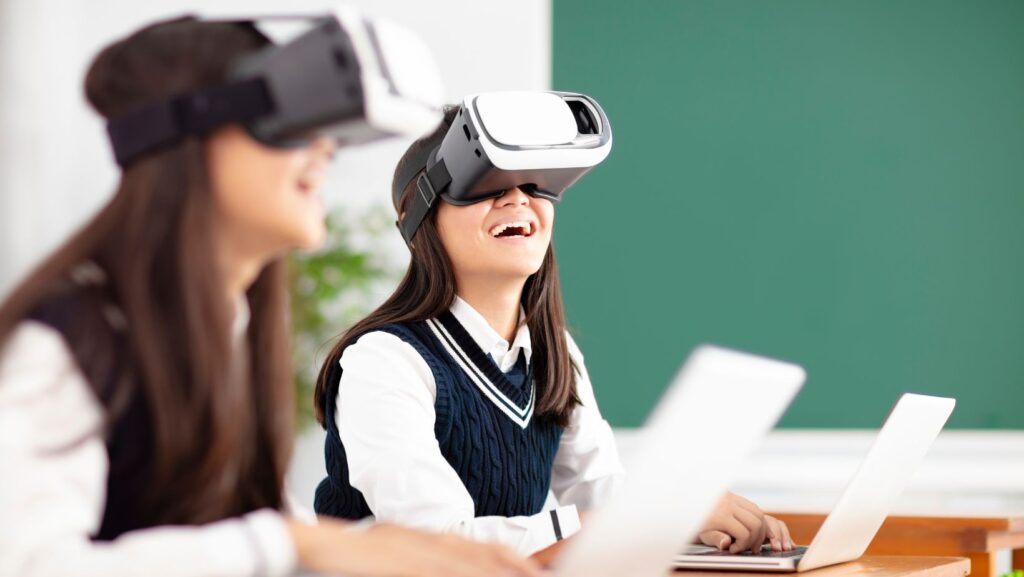

Virtual reality (VR) is making learning more exciting everywhere, not just in high-tech places but in classrooms around the world. Imagine putting on a VR headset and walking through ancient Rome’s beautiful buildings or exploring the complex structure of a human cell — all in one school day.
The potential of VR in education is huge, and the numbers really show how fast it’s catching on. The global market for VR, in general, is expected to grow from $17.18 billion in 2024 to an impressive $65.5 billion by 2032, which means it’s growing really fast, by over 18% each year.
This increase in VR use brings many benefits but also some challenges and limitations, which are important to talk about.
For anyone interested in how new technologies like VR are changing education, checking out some good argumentative essay topics on this subject can offer a deeper understanding and spark interesting conversations.
The Current State of VR in Education
VR is transforming the way students learn by bringing lessons to life in ways that regular teaching can’t match.
In classrooms, for example, programs like Google Expeditions (now part of Google Arts & Culture) took students on virtual trips to over 200 places around the world, from the deep sea to outer space. This helped students see and understand complicated topics in a whole new way.
In science labs, VR is used to simulate experiments that are either too dangerous or too expensive to conduct in a real-life setting. For example, medical students at Stanford University use VR to practice intricate surgical procedures, which reduces risk and increases their confidence before they operate on real patients.

For students who can’t make it to a physical classroom, VR is changing the game too. Platforms like Engage VR let students attend classes and meet with others in a virtual space as if they were together in person. This not only keeps the learning going but also helps students feel connected, no matter where they are.
Benefits of VR in Education
Virtual reality (VR) in education brings a lot of benefits that make learning more interactive and engaging:
- Makes Learning Fun and Engaging: VR turns lessons into interactive experiences, which can make learning more exciting. Students can travel through history, explore outer space, or dive into the human body.
- Personalizes Learning: With VR, lessons can adapt to each student’s learning pace. This helps everyone learn better, whether they need more time or want to speed ahead.
- Improves Understanding: VR helps with tough subjects by letting students see and interact with complex ideas, like scientific models and historical events, in a three-dimensional space.
- Increases Accessibility: Students with disabilities can experience activities and field trips they might miss out on, thanks to VR’s ability to simulate almost any environment.
- Encourages Collaboration: Students from around the world can work together in a virtual space, sharing ideas and learning from each other, which is great for building teamwork skills.
- Keeps Students Safe: VR allows students to conduct experiments and explore potentially dangerous places without any real-world risks.
- Boosts Attendance and Motivation: Classes with VR are often more appealing to students, leading to better attendance and more active participation.
Challenges and Limitations of VR in Education
While virtual reality (VR) opens up exciting new ways to learn, it also comes with challenges and limitations that schools need to consider:

- High Costs: The price tag of VR gear and software can be steep. Schools have to buy not just the headsets but also the computers and programs to run them. For example, outfitting a classroom with high-quality VR setups can cost thousands of dollars, which might be tough for many schools to afford.
- Technical Demands: Beyond just the headsets, VR requires powerful computers with advanced graphics to run properly. These systems need regular updates and maintenance, which can add extra costs and require more from IT staff.
- Health Concerns: Spending too much time in VR can lead to issues like eye strain and headaches, and some people might even feel motion sick. Schools need to think about how long students should use VR at one time, making sure they take breaks to help prevent these problems.
Case Studies
VR is already making a big impact in schools around the world. At the University of Illinois, VR helps medical students practice surgeries in a virtual world. This allows them to learn and refine their skills without any real-life risks. Students appreciate this method because it makes their training more realistic and boosts their confidence.
The University of Exeter uses VR to teach tough subjects like chemistry and physics. Students can see and interact with 3D models of molecules and chemical reactions, which makes these complex concepts easier to grasp. This approach has helped students understand and remember challenging material more effectively.
These examples show how VR can transform education by making learning more interactive and engaging and helping students connect with difficult topics in a fun and memorable way.












